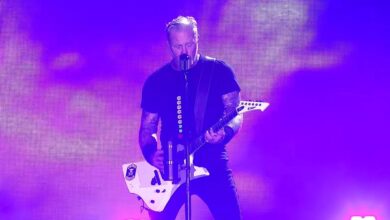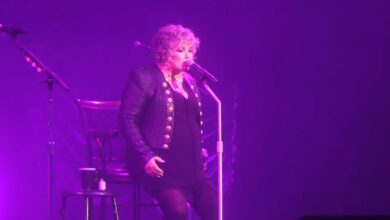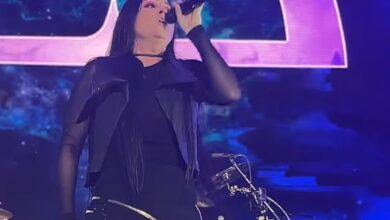Limp Bizkit’s 2025 Performance of “Break Stuff” Became Sam Rivers’ Unforgettable Farewell
The first clue that the night in Łódź would become one of Limp Bizkit’s most talked-about shows of the year appeared long before the lights went out. Fans streamed into the Atlas Arena hours early, wearing red Yankees caps, cargo shorts, and nostalgic grins. There was a buzz in the air that couldn’t be faked—a mix of excitement, mischief, and a promise of chaos that only a Limp Bizkit crowd can create. By the time the house lights dimmed, the roar was deafening, and the band stormed the stage like they had something to prove.
From the first beat, it was clear that this wasn’t just another stop on the European tour—it was a night destined for the books. Fred Durst prowled the stage like a veteran prizefighter, working every inch of the floor. Wes Borland, in his usual surreal stage attire, made his guitar scream and snarl, while John Otto’s drumming shook the rafters. The sound mix was tight, the energy feral, and the connection between band and crowd instantaneous. Łódź didn’t just witness a performance—it became a part of it.
The atmosphere inside Atlas Arena was pure combustion. The crowd didn’t wait for permission—they were jumping, shouting, and chanting every word before Durst even hit the mic. When “My Generation” blasted through the speakers, 10,000 fists went up in synchronized defiance. Poland’s audiences have a reputation for giving everything, and Limp Bizkit matched that intensity beat for beat. Every riff seemed to light a fuse; every chorus detonated with the precision of controlled chaos.
Borland’s guitar tone that night was unearthly. He layered distortion, squeals, and clean tones with a confidence that made even longtime fans take notice. You could hear the electricity hum through the air as he built tension before each chorus. Durst played the conductor, holding the crowd in the palm of his hand—one moment whispering into the mic, the next commanding them to scream like it was 1999 again.
Midway through the set, Durst called for something different: a moment of playfulness amid the aggression. He pulled a fan from the front row—a teenager wearing a vintage “Chocolate Starfish” tee—and handed him the mic. Together they tore through a few lines of “Nookie,” sending the crowd into a frenzy. The fan nailed it, and Durst laughed, patting him on the back. It was the kind of spontaneity that reminded everyone why Limp Bizkit shows feel alive in a way few others do.
But the real moment of transcendence came when the unmistakable opening riff of “Break Stuff” hit. You could feel the building inhale before it exploded. People surged forward, shouting every word like scripture. It wasn’t just a song—it was a collective purge. For four minutes, the Atlas Arena became a single, unified organism fueled by adrenaline, memory, and joy. The cameras shook from the force of the crowd; even the security guards grinned as they braced for impact.
The band played it like a battle cry. Otto’s drums were relentless, Rivers’ bass (recorded here on one of his final tours before his passing) punched with hypnotic precision, and Borland’s guitar sounded like pure chaos bottled and released. When Durst reached the final chorus, he didn’t have to sing—Łódź did it for him. Thousands of voices screamed in unison, echoing long after the last note faded.
The rest of the set swung between anthemic and introspective. “Behind Blue Eyes” offered a brief, almost spiritual pause—lighter screens glowing across the arena—before the band roared back into “Take a Look Around,” which hit like a jet engine. There were no wasted moments, no filler. Each song felt sharpened, heavier, and more deliberate than ever before.
The visual production elevated everything. Smoke cannons timed perfectly with drum hits, LED screens casting crimson silhouettes of Borland’s alien form, and lights pulsing like the heartbeat of the arena. Yet for all the spectacle, the focus always came back to the chemistry between the musicians—a dynamic that felt effortless even after decades.
As the final encore ended, Durst stood at the edge of the stage, looking out at the exhausted, ecstatic crowd. “Poland,” he said, “you’ve been the loudest of the tour. Respect.” The audience responded with one last chant, a wall of noise that seemed to vibrate the entire building. It was the kind of exchange that doesn’t fade; it lingers like smoke after fireworks.
In the following months, that night in Łódź became a legend among fans. Clips circulated online—crowd-sourced videos showing the chaos, the sweat, and the unity of that room. It wasn’t just nostalgia; it was proof that Limp Bizkit, two decades after their heyday, could still turn a stadium into an earthquake.
And then came the heartbreak. On October 18, 2025, news broke that bassist Sam Rivers had passed away at 48. The same man who’d anchored that thunderous performance in Poland was gone. Fans revisited the footage with new eyes, hearing the subtle swing in his lines, the way his tone carried both groove and grit. Those moments at Atlas Arena—his steady pulse beneath the storm—suddenly felt sacred.
Durst and Borland paid tribute online, describing Rivers as “the heartbeat” of Limp Bizkit and a friend who made chaos sound beautiful. Fans flooded comment sections with memories and clips from the March show, calling it one of the last nights they saw the full magic intact. Watching it again now, knowing what followed, gives it a haunting tenderness.
That performance of “Break Stuff” in Łódź now feels like both celebration and farewell. The same groove that once invited mayhem now carries melancholy—a reminder of a band that’s weathered decades but still finds a way to make every night matter.
When you watch those clips today, you don’t just see a rock show. You see four musicians, bonded by noise, giving everything they have to a crowd that gave it back tenfold. It’s loud, it’s raw, and it’s alive—and somewhere in that sound, Sam Rivers still plays on.





